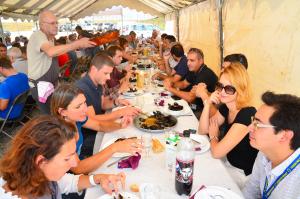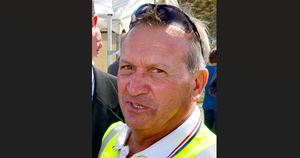Lamb on the spit to celebrate slab completion
21 Sep 2014
-
R.A.
From those who had worked on the rebar arrangement to the workers who had poured the concrete, they were all present. As whole lambs roasted slowly over the open fire, joy and pride could be read in the faces assembled around the tables.
The last time a méchoui was served at ITER it was 18 April 2012 and the 493rd—and final—seismic pad had just been installed in the Tokamak Complex Seismic Pit.
A North-African tradition, méchoui, or roast lamb on a spit, was back on site last Thursday 18 September ... along with mussels and boiled squid ... to celebrate the recent completion of the Tokamak Complex basemat.
From those who had worked on the rebar arrangement to the workers who had poured the concrete, they were all present: staff from GTM, the company that led the construction consortium; designers from Engage; safety specialists from Apave; management support personnel from Energhia; and of course staff from the ITER Organization and the European Domestic Agency Fusion for Energy.
Julio Diaz, the general foreman for the GTM says that the work "... was quite challenging, beginning with the nature of the rock and the extreme density and complexity of the steel reinforcement and culminating in the delicate positioning of the embedded plates. But the job was done, and well done..."
As whole lambs roasted slowly over the open fire, joy and pride could be read in the faces assembled around the tables. "Happy! I'm just happy," smiled Julio Diaz, a veteran construction worker and the general foreman for the GTM consortium. "I've been part of this adventure since the very first day in the summer of 2010. The work was quite challenging, beginning with the nature of the rock and the extreme density and complexity of the steel reinforcement and culminating in the delicate positioning of the embedded plates. But the job was done, and well done..."
This feeling of "mission accomplished" is shared by GTM's project director Thierry Lebeault. "What's particularly satisfying is the excellent result that we have achieved in terms of worker safety. I see two reasons for this good safety record: the high level of requirements from the building owner Fusion for Energy and our own commitment to safety and quality."
The méchoui offered by GTM isn't the end of the story. "There is still finishing work to be done on the slab that will keep us busy until the end of the year," says Diaz.
We can expect another méchoui when civil works are completed on the Tokamak Complex Building.



